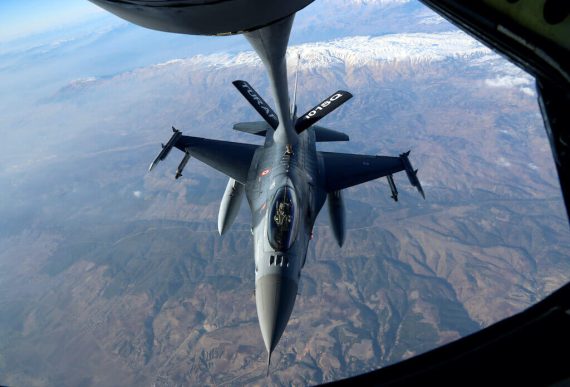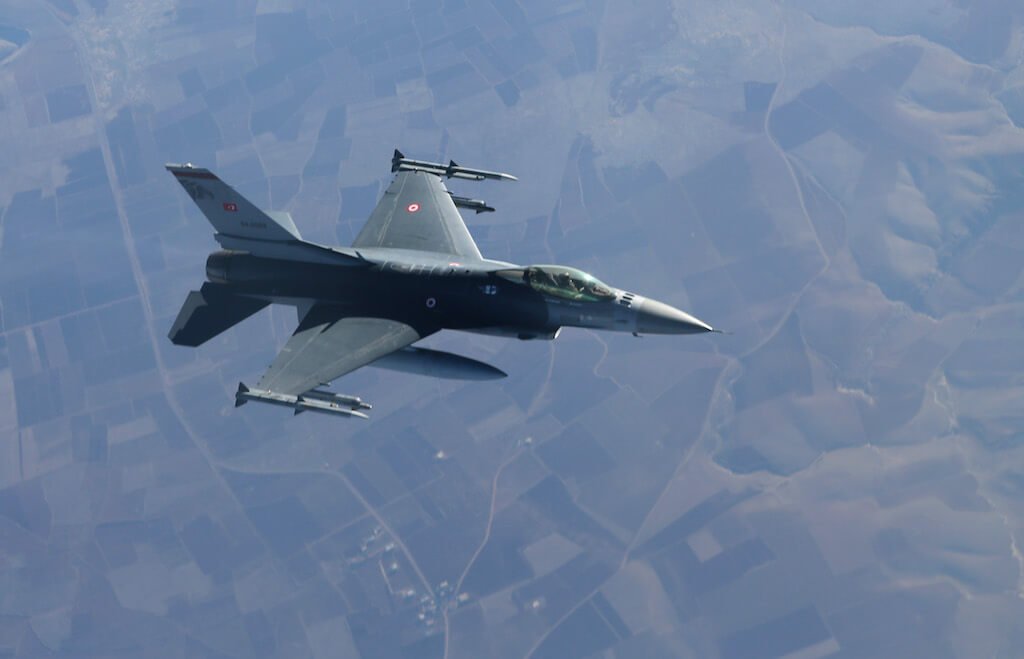Turkey has recently requested the sale of 40 F-16V fighter aircraft from the United States and upgrade kits for 80 F-16s in its inventory. This move came amidst the strained relations between the two countries and shortly after Turkey’s removal from the fifth-generation fighter aircraft F-35 Lightning II development project by the U.S. because of Ankara’s procurement of the S-400 air defense system from the Russian Federation.
Under normal conditions, the F-16 sale would be a military/technical matter, managed through complex bureaucratic procedures and formalities. However, due to the lengthy list of complex issues between Ankara and Washington, most of which have direct implications for Turkey’s near periphery and NATO alliance, the outcome of the F-16 inquiry will most likely be a major turning point in Turkey’s foreign relations.
To understand better the significance of Turkey’s possible F-16V procurement in terms of military capabilities and strategic implications, we must first take a look at Turkey’s current air power and force structure.
The F-16 and Turkey
Turkey is one of the major users of Lockheed Martin’s F-16 Fighting Falcon aircraft. The Turkish Air Force (TurAF) had taken delivery of a total of 270 F-16C/D Block 30, Block 40, Block 50, and Block 50+ aircraft.
Shortly after the lifting of the U.S. arms embargo in 1978, Turkey started a program to modernize its air force. The majority of the combat aircraft fleet was nearing the end of their useful service, and the lack of spares because of the embargo significantly decreased serviceability. As a result of a technical evaluation, the F-16 Fighting Falcon by General Dynamics was selected.
An agreement for the purchase of 160 F-16C/D Fighting Falcon aircraft was signed between Turkey and United States on December 9, 1983. The agreement covered the sale to Turkey of 160 F-16C/Ds, Block 30 and Block 40 versions, under a project designated “Peace Onyx” through local production.
Turkey’s Türk Uçak Sanayii A.Ş (TUSAŞ) formed a joint venture with General Dynamics, named TUSAŞ Aerospace Industries (TAI) and with General Electric under the name of TUSAŞ Engine Industries (TEI) for the manufacture of the F-16s and its engines, respectively. For the electronic warfare systems of the aircraft, another joint venture, named Mikrodalga Elektronik Sanayii (MIKES) was established.
The first eight aircraft were delivered to TurAF by General Dynamics in 1987, and following this, 152 aircraft were assembled by TAI, with the level of local contribution increasing in each production batch. Similarly, TEI assembled the F110-GE-100 turbofan engines of the aircraft, forming the baseline of an aerospace engine industry in the country. The first TAI-assembled aircraft entered service on November 27, 1987, and the last F-16 of Peace Onyx I was delivered in 1995.
Shortly after the completion of Peace Onyx, a follow-on project for additional F-16s began in 1992 under the name of Peace Onyx II. The costs of the project were met by Saudi Arabia, Kuwait, and the United Arab Emirates as compensation for Turkey’s support to the coalition during Operation Desert Storm in 1991. An agreement for 80 F-16C/D Block 50 aircraft was signed between Turkey and the United States on March 26, 1992. The assembly and deliveries of Peace Onyx II aircraft were performed by TAI between 1996 and 1999.
To compensate for attrition losses and also to fill the capability gap until the induction of next-generation aircraft, Turkey decided to order additional F-16s. In May 2007, an agreement with the United States was reached and 30 F-16C/D Block 50+ aircraft were ordered under the Peace Onyx IV program. One of these aircraft’s most distinctive features is their ability to carry additional fuel tanks on the airframe. These conformal fuel tanks (CFTs) increase range and thus the combat radius of the aircraft. Peace Onyx IV aircraft were delivered between 2011 and 2012.
F-16 upgrades
TurAF started a modernization project for the F-16 fleet in the early 2000s in order to increase the capabilities of the aircraft. Designated as Peace Onyx III, the project covered the upgrade of the mission systems of the aircraft. The project was started in July 2007 and covered a total of 175 Block 40 and Block 50 F-16s. A total of 35 Block 30 F-16s also received limited upgrade. TAI delivered the first aircraft to TurAF on November 2, 2011, and the project was completed in April 2015.
Meanwhile, Turkey also undertook a national upgrade program under the Özgür Project, which started in 2010. The project aims at the development of an indigenous mission computer and mission systems avionics for the F-16. With the nationalization of mission computers, the project aims to ensure the integration of national air-to-air and air-to-ground weapons. Furthermore, the experience gained from the Özgür Project will be incorporated into the advanced jet trainer and light attack aircraft HÜRJET, and Milli Muharip Uçak (MMU or National Combat Aircraft) fighter development projects. An F-16C Block 30 has been used as the prototype aircraft in the project, and the upgrade of the remaining Block 30 fighters is on the agenda.
Another major improvement of the F-16 fleet is the Structural Modernization Program, under a contract signed in 2015. The project covers structural improvement work to increase the service life of 35 F-16C/D Block 30 aircraft. With this modernization, the service life of the F-16C/D Block 30 aircraft is planned to be extended from 8,000 to 12,000 hours.
What is the F-16V?
The F-16V is the latest version of the F-16 Fighting Falcon family. The aircraft incorporates several improvements over the previous model – the most important of which is the new radar, named AN/APG-83. The AN/APG-83 is an active electronically scanned array (AESA) radar, which does not have any moving mechanical parts unlike its predecessors. AESA radars offer greater detection and tracking ranges, and are capable of tracking multiple targets compared to mechanical pulse-Doppler radars.
In addition to the AESA radar, the F-16V is equipped with a modern commercial off-the-shelf (COTS)-based avionics subsystem; a large-format, high-resolution cockpit display; and a high-volume, high-speed data bus. The flight control system is enhanced by an Automatic Ground Collision Avoidance System (Auto GCAS) to prevent crashes in case the pilot loses control due to blackout, which usually occurs during agile maneuvers. The service life of the aircraft has also increased from 8,000 flight hours to 12,000, thanks to structural improvements.
The F-16V is offered as a new production aircraft and an upgrade package to existing F-16s. Taiwan is the first customer of the F-16V solution as the country signed a $1.85 billion contract with the U.S. in 2012 to upgrade 142 F-16A/Bs. Singapore, South Korea, and Morocco signed contracts to upgrade their F-16s to the F-16V standard. The latest customer for the F-16V upgrade is Greece, which will have 84 of its F-16C/Ds modernized under an agreement signed with the U.S. in late 2019.
In addition to upgrade projects, there have been several contracts for newly built F-16Vs: a total of 149 F-16Vs have been ordered by Bahrain, Bulgaria, Morocco, the Philippines, Slovakia, and Taiwan. A heavily modified F-16V, designated as F-21, is being offered to India.
Turkey’s F-16V request
According to press reports, Turkey submitted a letter of request (LOR) to the U.S. government on September 30, 2021 for the acquisition of 40 F-16V aircraft and kits to upgrade 80 aircraft to the F-16V configuration.
The LOR is a document prepared by the customer government and submitted to the U.S. government to initiate the formal procedure under the Foreign Military Sales procurement system, which is one of the U.S. arms sales schemes. The LOR defines the requirement of the recipient government, the number and type of the weapon platform or system that is desired to be purchased, and the administrative details.
The preparation and submission of the LOR does not guarantee the sale per se, but it is important to note that during its preparation, militaries and bureaucracy from both sides work together, confer, and discuss the general content of the letter. Therefore, the submission of the LOR for the F-16Vs implies that some military/technical discussion between the Turkish and United States’ militaries had taken place.
So, why has Turkey asked for F-16s from the U.S. that previously denied the delivery of F-35 next-generation combat aircraft and imposed sanctions on it?
The procedure’s next milestone is the approval by the U.S. government and congress. Subject to many factors – most of which are political – upon getting congressional approval, the U.S. Department of Defense will prepare a letter of offer and acceptance (LOA), which can be described as a contract. Therefore, the F-16V request will be a stress test for the relationship between Turkey and U.S., which has already been extremely strained for the past few years.
So, why has Turkey asked for F-16s from the U.S. that previously denied the delivery of F-35 next-generation combat aircraft and imposed sanctions on it? There are two main factors that resulted in this request.
Turkish Air Force’s current and future capabilities
The first factor is the structure of the TurAF. Until late 2010, TurAF’s modernization plans, and road map had been based on two major programs: F-35 Lightning II and Milli Muharip Ucak (MMU).
Turkey was a Level III industrial partner to the F-35 program and starting in 2018, TurAF was to receive 100 F-35A fighter jets for the 7th and 1st Main Jet Bases. The Turkish Navy was also interested in the aircraft, specifically the F-35B Short Takeoff and Vertical Landing (STOVL) version to use it with the TCG Anadolu amphibious assault ship, which is under construction. However, due to Turkey’s procurement of the S-400 air defense system from the Russian Federation, the U.S. removed Turkey from the F-35 project and cancelled the delivery of the aircraft that it had already produced.
The Turkish Navy was interested in F-35B, specifically the F-35B Short Takeoff and Vertical Landing (STOVL) version to use it with the TCG Anadolu amphibious assault ship, which is under construction.
The MMU program started in 2011 with the conceptual design phase, which was completed in 2013. The program is currently in the preliminary design phase. Turkish Aerospace, the main contractor, plans to roll out the first prototype in 2023 and the first flight is expected to take place in 2026 with service entry commencing towards the end of the decade. The MMU is planned to form the backbone of the TurAF combat fleet and will operate until 2070.
The MMU is envisaged as incorporating many state-of-the-art technologies and capabilities such as very low observability, advanced sensors, and data-link systems as well as the capability to carry a wide range of guided weapons, all of which are characteristic features of fifth-generation combat aircraft such as F-22, F-35, J20, and Su57. The MMU’s abilities will be further enhanced through extensive use of artificial intelligence (AI) and neural networks (NN).
Despite all the aforementioned promising features and capabilities, service entry and full operational capability of an adequate number of MMUs will see the light in the first half of the 2030s. The retirement of the F-4Es in the 2020s and the absence of F-35As combined with the schedule of the MMU program will likely result in with a quantitative and qualitative gap for the TurAF.
Recommended
Regional developments in the air power domain
Almost all the countries surrounding Turkey have been allocating significant resources for the upgrade of their air forces. One significant example is Greece, which ordered a total of 24 Rafale combat aircraft from France in two batches. Additionally, 84 F-16s belonging to the Greek Air Force are being upgraded to the F-16V standard. Meanwhile, Greece declared an interest in acquiring the F-35 and reportedly submitted an LOR to U.S. in late 2020.
Israel fields one of the largest air forces in the Middle East and is the only operator of the F-35 in the region. So far, Israel has taken delivery of more than 25 F-35As, in addition to owning 80 F-15A/B/C/D/Is and more than 220 F-16C/D/Is.
In the case of a denial of F-16Vs, Turkey will definitely look for alternatives, as repeatedly stated by its officials.
The third major air power in the region is Egypt. Since the coup in July 2013, the country has started a massive armament initiative with emphasis given on air force and navy. Egypt acquired 24 Rafale fighter jets from France between 2016 and 2019 while 50 MiG-29Ms were ordered from Russia followed by an order for 24 Su35s. In early 2020, there were reports of contract negotiations with Italy for Eurofighter Typhoon combat aircraft and M346 trainers.
Conclusion
As a major user of the F-16, Turkey’s selection of the newest variant of the aircraft, namely the F-16V, is the most rational choice for fulfilling a capability gap, since such a procurement will require minimum infrastructure, logistics, and training costs as compared with other alternatives, such as using a European or Russian fighter. Inducting a completely new type of aircraft requires considerable time and budget: training of pilots and personnel, establishment of ground support systems and infrastructure, and training and achievement of operational readiness.
Therefore, the request for the F-16Vs becomes a political test for Turkey-U.S. relations: if the request is denied because of Turkey’s procurement of the S-400, as was the case for the denial of the F-35s, this might mean that the Turkey-U.S. alliance is reduced to nothing more than a transactional relationship limited mostly to regional issues and on a limited scale.
The introduction of 40 F-16Vs and the upgrade of 80 fighters to the same level will certainly act as a cost-effective stopgap solution for Turkey until indigenous projects such as the MMU, the Muharip İnsansız Uçak Sistemi (MIUS) unmanned combat aircraft, and advanced jet trainer and light attack aircraft HÜRJET come to light. This capability boost will also reinforce NATO’s southern flank, a very important parameter given Turkey’s active contribution to the alliance.
In the case of a denial of F-16Vs, Turkey will definitely look for alternatives, as repeatedly stated by its officials. In such a scenario, as the second President of Turkey İsmet İnönü once said, “A new world order will be established with Turkey in it.”






